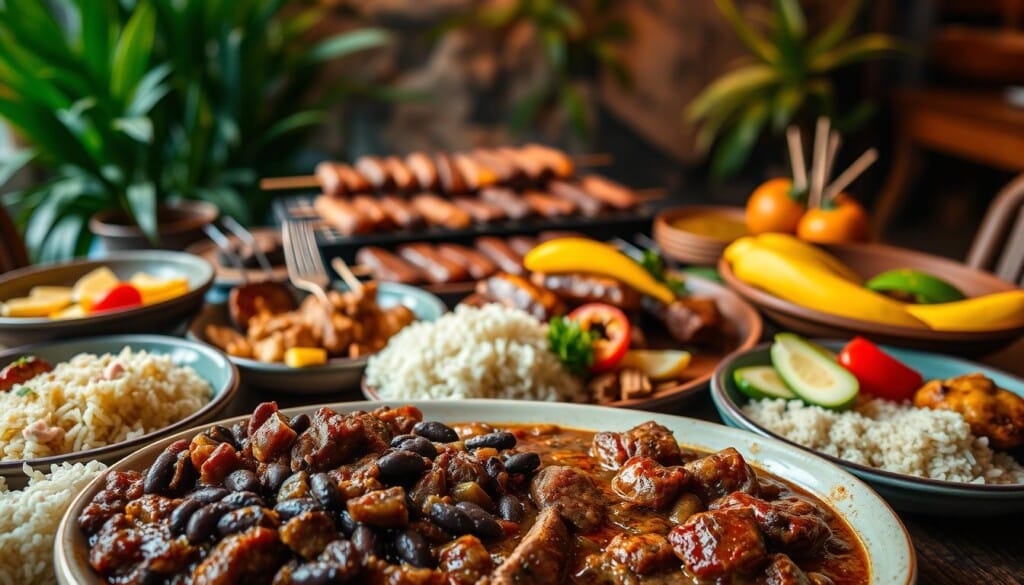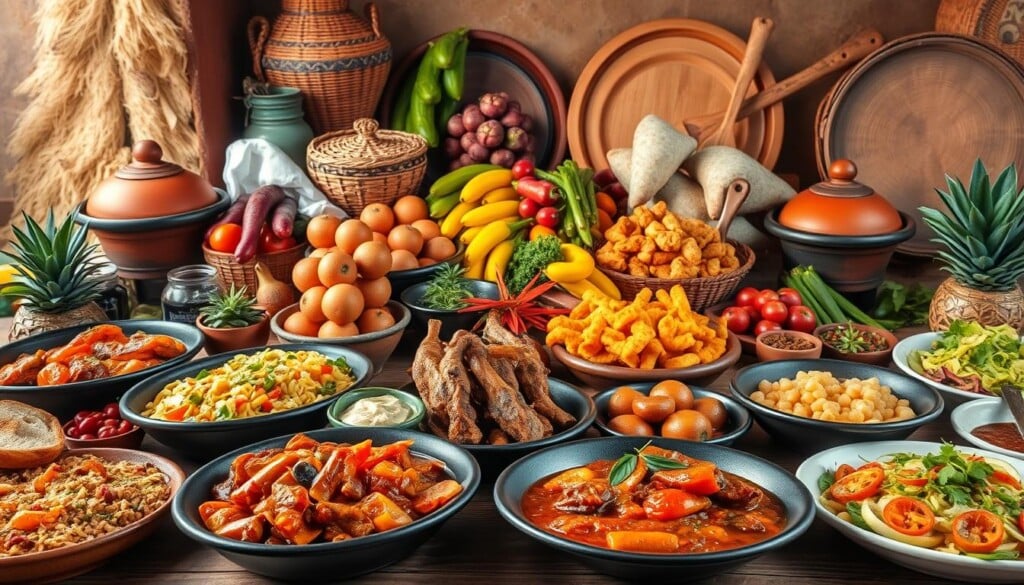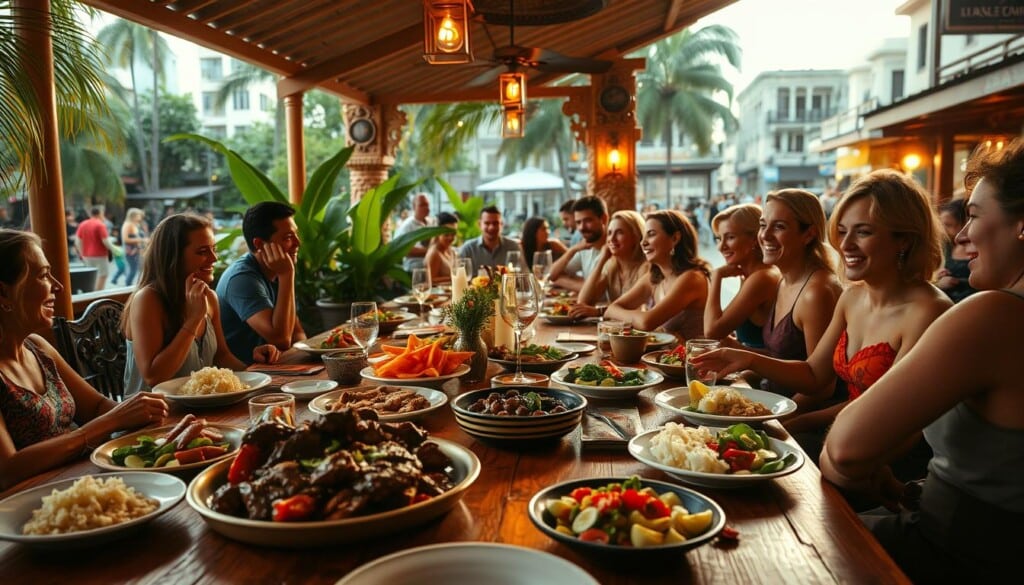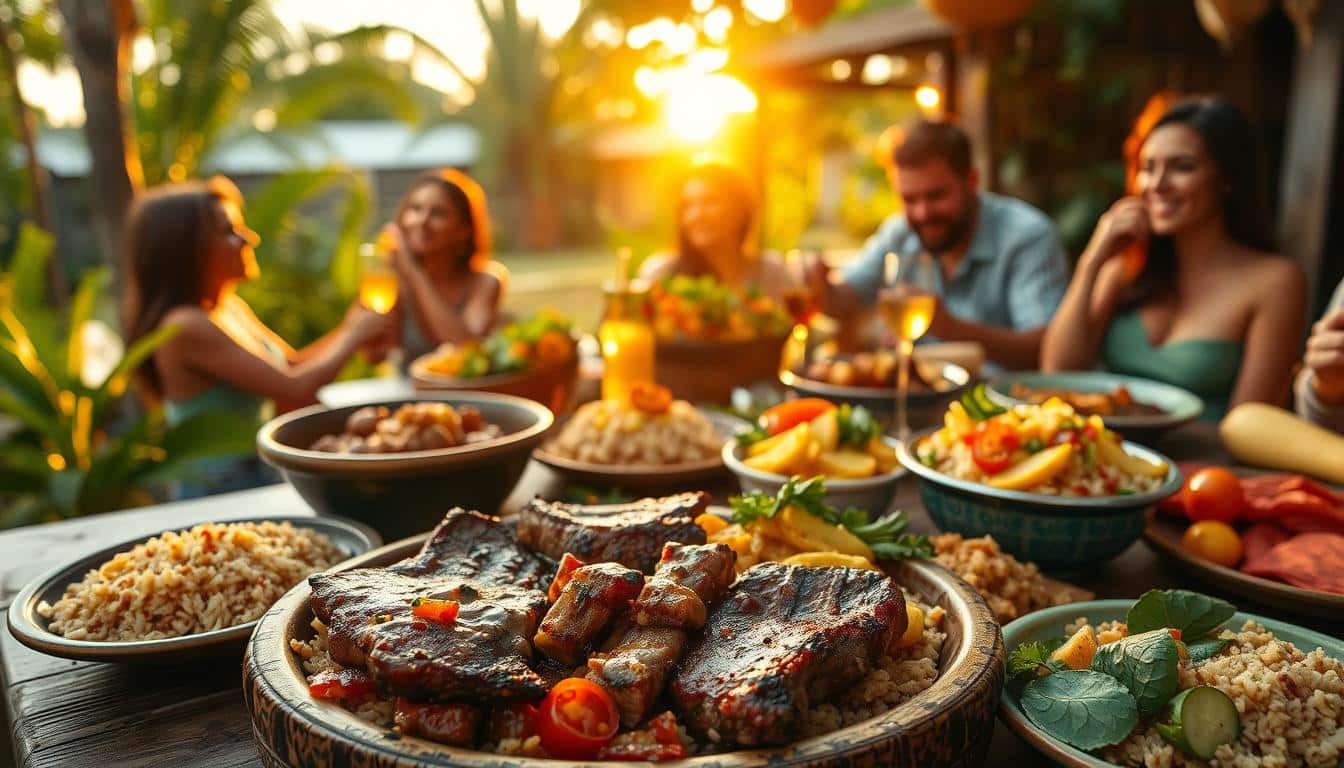Ever wondered why Brazilian food is so loved? Exploring Brazilian food restaurants in the USA is a journey of unique tastes and rich culture. It’s a chance to experience the flavors and traditions of Brazil.
This article will show you the best Brazilian restaurants in the USA. They are true to Brazilian culture and offer amazing dining experiences. You’ll discover the flavors and traditions that make Brazilian food special.
Key Takeaways
- Explore the diverse culinary landscape of Brazilian food restaurants in the USA.
- Discover the unique flavors of authentic Brazilian cuisine.
- Learn about some of the top Brazilian restaurants across major cities.
- Understand what makes Brazilian dining experiences unique.
- Engage with the community through local Brazilian food festivals.
Introduction to Brazilian Cuisine
Brazilian cuisine is known for its vibrant and diverse dishes. This is thanks to the country’s rich mix of cultures. Portuguese, African, and Indigenous influences have combined to create unique flavors.
This blend has led to both classic and modern dishes. Quality ingredients and cooking techniques are key. They make Brazilian food special.
The Rich Flavors of Brazil
The flavors in Brazil come from its different regions. Each area has its own taste. Spices and herbs add to the flavor of dishes.
Ingredients like black beans and meats make dishes complex. This makes Brazilian food a treat for the senses.
Key Ingredients in Brazilian Dishes
Cassava is a staple in Brazilian meals. It’s joined by meats and spices. These ingredients are the heart of Brazilian cuisine.
They also show the cultural importance of these foods. The mix of ingredients and cooking methods keeps Brazilian flavors alive in every bite.
Popular Brazilian Dishes to Try
Brazilian food is full of flavors, each dish with its own story. Feijoada, the national dish, is a black bean stew with many meats. It’s served with rice, farofa, and orange slices, showing Brazil’s warm welcome.
Feijoada: The National Dish
Feijoada is more than food; it’s a big part of Brazilian culture. People come together on special days and Sundays to enjoy it. The mix of flavors makes it a dish full of history and taste.
Pão de Queijo: Cheesy Bread Balls
Pão de Queijo are small, cheesy bread balls loved by many. They’re made from tapioca flour and are chewy. You can find them in homes and bakeries, enjoyed at any time.
Brigadeiros: Sweet Treats for All
Brigadeiros are the sweet treats of Brazil. Made from condensed milk, cocoa, and butter, they’re rolled in chocolate sprinkles. They’re a favorite at celebrations and for anyone who loves sweets.
Exploring these dishes is easy through listing on local directories. Each dish has its own tale, waiting to be discovered.

Exploring Regional Varieties of Brazilian Food
Brazil’s food scene is full of different tastes and traditions. Each region brings its own twist to Brazilian cuisine. The Amazon and Bahia are two places that stand out, with their own special dishes.
Amazonian Flavors
The Amazon is famous for its unique ingredients and cooking ways. You’ll find fruits like açaí and cupuaçu, straight from the rainforest. Grilled fish, like tambaqui, is also popular, served with local veggies.
The Amazon’s focus on using what’s available shows its people’s deep bond with nature. This makes enjoying Brazilian food even more meaningful.
Bahian Cuisine: Spice and Seafood
Bahian food is all about bold spices and seafood. Moqueca, a fish stew, is a big hit. It’s made with coconut milk, palm oil, and herbs, showing the Afro-Brazilian influence.
These dishes are a true celebration of Bahian culture. For more on Brazilian food, check out LocalZ. They can help you find restaurants near you that serve these amazing flavors.

How to Find Brazilian Restaurants Near You
Finding the best Brazilian restaurant nearby is now easier with online directories. Sites like LocalZ make it simple to find local restaurants. You can search for Brazilian food near you and discover hidden gems in your area. LocalZ’s easy-to-use interface helps you find restaurants based on how close they are and what others say about them.
When looking for Brazilian food, start by filtering search results. Look for high customer ratings and dishes you like. Reading reviews helps you understand the restaurant’s quality and authenticity. Look for mentions of feijoada or pão de queijo to find the best spot.
Using LocalZ makes finding restaurants easier and helps you make better choices. Real customer feedback makes your selection more reliable. This way, you can enjoy Brazilian food in your community.
Dining in Brazilian Restaurants: What to Expect
Dining in Brazilian restaurants is a vibrant journey into Brazil’s rich culinary world. You’ll find a mix of flavors, aromas, and traditional customs. Every detail, from service to presentation, is designed to make your experience special.
Traditional Dining Experience
At a Brazilian restaurant, you’ll get a warm welcome that starts your meal off right. The decor and music reflect Brazil’s rich heritage. You’ll feel the warmth of Brazilian culture through the outstanding hospitality.
Dishes are served in big portions, encouraging diners to share. This creates a sense of community and connection.
Understanding the Rodízio Style
The rodízio style is the heart of Brazilian dining. It offers a continuous flow of grilled meats, served tableside by skilled waitstaff. You’ll get to try beef, pork, chicken, and lamb, each with its own flavors.
This style focuses on variety and quality. It makes every bite a celebration of culinary excellence. Enjoying this service lets you experience the joy of trying many flavors, showing the essence of Brazilian cuisine.

Celebrating Brazilian Culture at Food Festivals
Brazilian food festivals are lively displays of the country’s rich food culture. They take place in different places in the United States. These events celebrate tasty food and the traditions of Brazilian cuisine.
Visitors get to enjoy live music, cooking shows, and cultural acts. It’s a great way to dive into Brazil’s varied food scene.
Major Brazilian Food Festivals in the USA
Many big Brazilian food festivals are popular in the USA. Events like the Taste of Brazil Festival in Los Angeles and the Brazilian Day Festival in New York showcase Brazilian dishes. These include feijoada and pão de queijo.
Each festival lets local chefs show off their talents. It also introduces people to the unique tastes of Brazilian food.
Community Engagement at Food Events
Food festivals in Brazil are all about bringing people together. They help create a sense of community among those who attend. People can share their food experiences and celebrate different cultures.
Workshops and interactive sessions are part of these events. They teach about food and help build stronger community bonds. It’s all about sharing food and making connections.
Supporting Local Businesses with LocalZ
In today’s market, backing local businesses is key. LocalZ is a vital local business directory. It connects people with nearby Brazilian restaurants and more. It helps build a stronger community and encourages people to try local options.
The Role of LocalZ in Community Connections
LocalZ is a bridge between businesses and customers. It lets restaurants list their services and reach people who love Brazilian food. This boosts community ties and promotes Brazilian culture through food.
Benefits of Listing with LocalZ
Listing with LocalZ helps businesses reach customers who want to support locals. It makes them more visible and invites people to try Brazilian dishes. Plus, a part of the fees goes to Community Affiliates, helping the local economy grow.
Conclusion: Savoring Brazilian Flavors Locally
Exploring Brazilian cuisine shows us it’s more than just food. It’s about the connections we make through it. By diving into local culinary traditions, we get a unique and enriching experience. Each meal connects Brazil’s rich heritage with our local culture.
Engaging with Local Culinary Traditions
Trying Brazilian food does more than just please our taste buds. It brings us closer to our community through food. Celebrations of Brazilian food show us the value of local ingredients and cooking methods.
By supporting these restaurants, we help the hospitality sector grow. We also join in a cultural conversation that food makes possible.
Encouraging Community Involvement Through Food
The journey through Brazil’s flavors invites us to get involved in our local food scene. By visiting Brazilian restaurants and joining in food events, we learn about cultural diversity. Embracing these chances enriches Brazilian traditions and strengthens our community bonds.
It lets us come together, united by our love for food.

